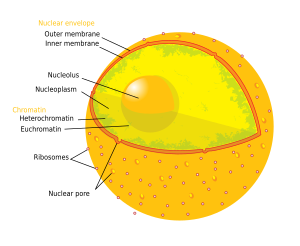
Back بلازم نووي Arabic Nukleoplazma Azerbaijani Кариоплазма Bulgarian নিউক্লিওপ্লাজম Bengali/Bangla Nukleoplazma BS Nucleoplasma Catalan Karyoplazma Czech Karyoplasma German Nucleoplasma Spanish Karüoplasma Estonian

The nucleoplasm, also known as karyoplasm,[1] is the type of protoplasm that makes up the cell nucleus, the most prominent organelle of the eukaryotic cell. It is enclosed by the nuclear envelope, also known as the nuclear membrane.[2] The nucleoplasm resembles the cytoplasm of a eukaryotic cell in that it is a gel-like substance found within a membrane, although the nucleoplasm only fills out the space in the nucleus and has its own unique functions. The nucleoplasm suspends structures within the nucleus that are not membrane-bound and is responsible for maintaining the shape of the nucleus.[2] The structures suspended in the nucleoplasm include chromosomes, various proteins, nuclear bodies, the nucleolus, nucleoporins, nucleotides, and nuclear speckles.[2]
The soluble, liquid portion of the nucleoplasm is called the karyolymph[3] nucleosol,[4] or nuclear hyaloplasm.
- ^ "karyoplasm". Collins English Dictionary. Retrieved 2 December 2022.
- ^ a b c "The human cell in nucleoplasm". Human Protein Atlas.
- ^ "karyolymph". Collins English Dictionary. Retrieved 2 December 2022.
- ^ Kühn, T; Ihalainen, TO; Hyväluoma, J; Dross, N; Willman, SF; Langowski, J; Vihinen-Ranta, M; Timonen, J (2011). "Protein diffusion in mammalian cell cytoplasm". PLOS ONE. 6 (8): e22962. doi:10.1371/journal.pone.0022962. PMC 3158749. PMID 21886771.